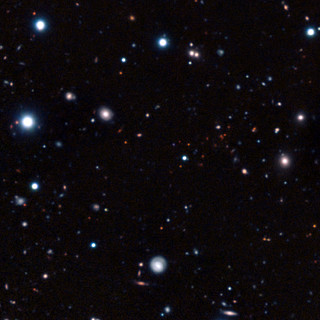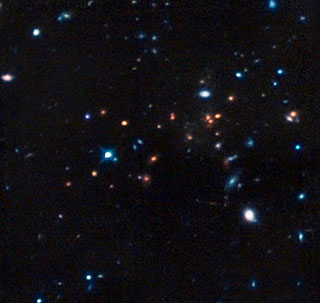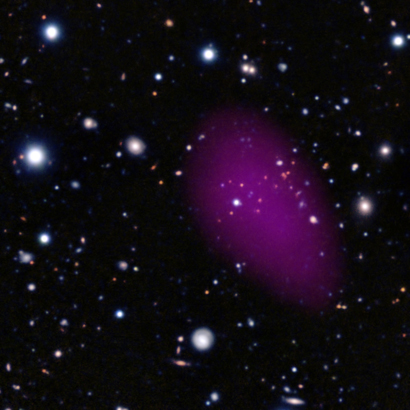European Southern Observatory | 2011 Mar 09
Young, but surprisingly grown-upAstronomers have used an armada of telescopes on the ground and in space, including the Very Large Telescope at ESO’s Paranal Observatory in Chile to discover and measure the distance to the most remote mature cluster of galaxies yet found. Although this cluster is seen when the Universe was less than one quarter of its current age it looks surprisingly similar to galaxy clusters in the current Universe.
“We have measured the distance to the most distant mature cluster of galaxies ever found”, says the lead author of the study in which the observations from ESO’s VLT have been used, Raphael Gobat (CEA, Paris). “The surprising thing is that when we look closely at this galaxy cluster it doesn’t look young — many of the galaxies have settled down and don’t resemble the usual star-forming galaxies seen in the early Universe.”
Clusters of galaxies are the largest structures in the Universe that are held together by gravity. Astronomers expect these clusters to grow through time and hence that massive clusters would be rare in the early Universe. Although even more distant clusters have been seen, they appear to be young clusters in the process of formation and are not settled mature systems.
The international team of astronomers used the powerful VIMOS and FORS2 instruments on ESO’s Very Large Telescope (VLT) to measure the distances to some of the blobs in a curious patch of very faint red objects first observed with the Spitzer space telescope. This grouping, named CL J1449+0856, had all the hallmarks of being a very remote cluster of galaxies. The results showed that we are indeed seeing a galaxy cluster as it was when the Universe was about three billion years old — less than one quarter of its current age.
Once the team knew the distance to this very rare object they looked carefully at the component galaxies using both the NASA/ESA Hubble Space Telescope and ground-based telescopes, including the VLT. They found evidence suggesting that most of the galaxies in the cluster were not forming stars, but were composed of stars that were already about one billion years old. This makes the cluster a mature object, similar in mass to the Virgo Cluster, the nearest rich galaxy cluster to the Milky Way.
Further evidence that this is a mature cluster comes from observations of X-rays coming from CL J1449+0856 made with ESA’s XMM-Newton space observatory. The cluster is giving off X-rays that must be coming from a very hot cloud of tenuous gas filling the space between the galaxies and concentrated towards the centre of the cluster. This is another sign of a mature galaxy cluster, held firmly together by its own gravity, as very young clusters have not had time to trap hot gas in this way.
As Gobat concludes: “These new results support the idea that mature clusters existed when the Universe was less than one quarter of its current age. Such clusters are expected to be very rare according to current theory, and we have been very lucky to spot one. But if further observations find many more then this may mean that our understanding of the early Universe needs to be revised.”
ESA / HEIC | 2011 Mar 09
An old galaxy cluster discovered in the young Universe“We have measured the distance to the most remote mature cluster of galaxies ever found,” says the lead author of the study, Raphael Gobat (CEA, Paris). “The surprising thing is that that when we look closely at this galaxy cluster it doesn’t look young — many of the galaxies have settled down and don’t resemble the usual star-forming galaxies seen in the early Universe.”
Clusters of galaxies are the largest structures in the Universe that are held together by gravity. Astronomers expect these clusters to grow through time and so massive clusters should be rare in the early Universe. Although very distant clusters have been seen before, they appear to be young clusters in the process of formation, and are not settled, mature systems like this one.
The cluster, called CL J1449+0856 [1], was first spotted by the NASA Spitzer Space Telescope, and its distance measured using the Very Large Telescope at the European Southern Observatory (ESO). This showed it lies far away at a redshift of around 2.07, meaning we see it about three billion years after the Big Bang, or less than a quarter of the Universe’s current age.
Astronomers then used the NASA/ESA Hubble Space Telescope to investigate its structure. They found evidence suggesting that most of the galaxies in the cluster were not forming stars, but were composed of stars that were already about one billion years old. This makes the cluster a mature object, similar in mass to the Virgo galaxy cluster, the nearest rich galaxy cluster to the Milky Way.
Further evidence that this is a grown-up cluster comes from X-ray observations made with ESA’s XMM-Newton space observatory, which confirmed the presence of hot gas between the cluster’s galaxies — a telltale sign of a mature cluster.
ESA Science & Technology | XMM Newton | 2011 Mar 09
A mature cluster with X-ray emission at z = 2.07 - R Gobat et alAstronomers working with data from several observatories, including ESA's XMM-Newton, have discovered the most distant, mature galaxy cluster yet. The cluster is seen as it was when the Universe was only about a quarter of its current age. In contrast to other structures observed in the young Universe, this object is already in its prime, as is evident from its diffuse X-ray emission and evolved population of galaxies. This shows that fully-grown galaxy clusters were already in place this early in cosmic history.
According to the most widely accepted theory, structure in the Universe grows in a hierarchical fashion: under the effect of gravity, smaller objects build up first, and then accrete into progressively larger ones. This is why galaxy clusters, the largest cosmic structures that are bound by gravity, are the last to form. When these enormous assemblies of galaxies, hot gas and dark matter appeared in the cosmos is still an open question, and the urge to resolve this question drives astronomers to observe galaxy clusters that are as distant as possible.
Given that galaxy clusters are scarce, and even more so at high redshifts where they are still taking shape, these observations are challenging. "This is why discovering a galaxy cluster at a redshift of 2 feels like unearthing a rare and valuable gem," says Raphael Gobat from the Commissariat à l'Énergie Atomique (CEA), in France, who led the extensive study that revealed what appears to be the most distant galaxy cluster detected yet.
CL J1449+0856, the newly-found galaxy cluster, is seen at an era when the Universe was only 3 billion years old — less than a quarter of its present age. "As well as being at a record-breaking distance, what makes this object rather unique is that it's not a proto-cluster undergoing formation, as are many that have been detected at high redshifts, but it is already mature, a proper galaxy cluster," adds Gobat.
A signature of its advanced evolutionary state is the diffuse X-ray emission associated with the cluster, observed with ESA's XMM-Newton. "Only galaxy clusters that have had time to fully develop, collapsing under the influence of their own gravity, are visible in X-rays," explains Alexis Finoguenov from the Max-Planck-Institut für extraterrestrische Physik (MPE), in Germany, co-author of the paper in which the result is presented. The X-ray emission originates from the hot intra-cluster gas: subject to the cluster's gravitational potential, the gas is compressed and heated to temperatures of over 10 million Kelvin, and shines at X-ray wavelengths.
The X-ray data not only show evidence that this is a fully-formed cluster, but also allow characterisation of its properties. The researchers estimate that the mass of the cluster is about 5-8 × 1013 solar masses. "The cluster has a moderate mass, as expected at such an early epoch, and corresponds to the progenitor of massive structures observed in the local Universe, such as the Coma cluster," adds Finoguenov.
With masses that have not yet reached extreme values, high-redshift clusters are relatively faint X-ray sources and are thus particularly hard to observe. Furthermore, their emission peaks in the soft X-ray band. "As it is more sensitive to soft X-rays than other instruments, XMM-Newton is the ideal tool to detect the signal from mature clusters in the young Universe," remarks Norbert Schartel, ESA'S XMM-Newton Project Scientist.
This remarkable finding is the result of a multi-wavelength study which lasted roughly five years and involved a number of observation facilities on the ground as well as space-based telescopes. Originally, the cluster was identified while analysing infrared data from NASA's Spitzer Space Telescope. "We stumbled upon this galaxy cluster by chance: the structure caught our eyes as a clump of galaxies which appeared much redder and more concentrated than those in the surroundings," notes co-author Emanuele Daddi, also from CEA. The team then ran a follow-up campaign to assess the redshifts of the galaxies, and their measurements confirmed that the galaxies are indeed close to each other, forming a cluster at redshift z~2.
They also examined the characteristics of the galaxies in greater detail using data that included observations by the NASA/ESA Hubble Space Telescope, and found that most of them have quite compact shapes, consistent with what is expected for galaxies with a bulge dominated by old stars. "The fact that the stellar populations in the galaxies had time to evolve is an additional sign of the cluster's maturity, along with its X-ray signal," Daddi adds. The evidence obtained all points in the same direction, but the team's efforts are not over and they are investigating this structure in even greater detail to study how early galaxy formation and the assembly process of a galaxy cluster are affected by the environment.
A serendipitous discovery corroborated by a body of deep and high-quality data, the record set by this finding is unlikely to be broken in the near future, as theory predicts that chances of finding similar clusters at redshifts of 2 or more using state-of-the-art instruments are low — only about a few per cent. "A single detection like ours is compatible with this small probability and can still be accommodated within current cosmological models," explains Gobat. However, if deeper and larger surveys were to detect more objects like this, the most widely accepted theory for the formation of cosmic structure would require revision. "This discovery has shown, for the first time, that old clusters were already present in the young Universe and that we are able to observe them. Only time will tell us what 'old' and 'young' really mean and what this implies in the broader context of cosmology," he adds.
- Astronomy & Astrophysics 526 A133 (2011 Feb) DOI: 10.1051/0004-6361/201016084
arXiv.org > astro-ph > arXiv:1011.1837 > 08 Nov 2010 (v1), 10 Dec 2010 (v2)


